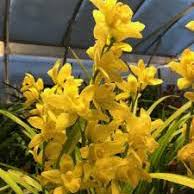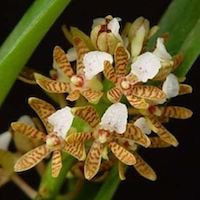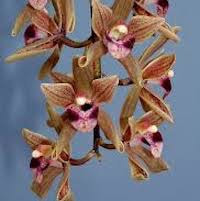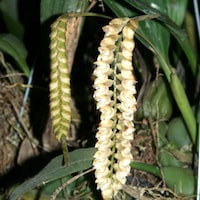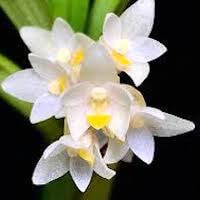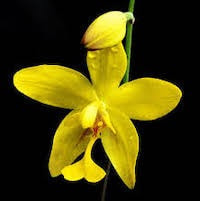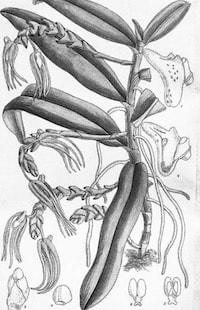Experience the Essence of Well-Being with Citrus Aromatherapy for Women
This essential oil has scented notes of different orchid species and their therapeutic uses. The Cymbidium golden Elf orchid is known for its ornamental and fragrant qualities. It is easy to care for, beautiful to look at, and produces a high number of flowers. Its scent is described as a soft mix of lemon and yuzu, giving it a fresh morning smell.
The Acampe praemorsa orchid is used therapeutically in various cultures. In India, a decoction of its roots called Rasna is used as a bitter tonic for rheumatism, sciatica, neuralgia, syphilis, and uterine disorders. The Dongria Kandha tribe consumes a tablespoon of the root paste to alleviate arthritis, while the Koya tribe applies a paste of the pulverized plant on fractured limbs for healing. In Nepal, the powdered root is used for treating rheumatism and providing a cooling effect.
The Cymbidium devonianum Paxton orchid is distributed in Nepal, Bhutan, Bangladesh, Yunnan, Myanmar, Thailand, and Vietnam. In Nepal, a paste of its root is applied to boils, and a decoction of the plant is consumed for coughs and colds.
The Pholidota imbricata Hook. f. orchid is found in various regions, including China, Sri Lanka, Southeast Asia, New Guinea, and Australia. It has therapeutic uses such as relieving fever, facilitating childbirth, inducing menstrual flow and diuresis, treating ulcers, and providing pain relief. In Nepal, the juice from its pseudobulbs is applied to boils and used to alleviate navel, abdominal, and rheumatic pain.
These orchids contain specific compounds with medicinal properties. Acampe praemorsa contains flavidinin and praemorsin, Cymbidium devonianum Paxton has scent oil perfume ingredients, and Pholidota imbricata Hook. f. contains imbricatin and coelonin.
Overall, these orchids offer both aesthetic appeal and potential therapeutic benefits in various traditional practices.
The Acampe praemorsa orchid is used therapeutically in various cultures. In India, a decoction of its roots called Rasna is used as a bitter tonic for rheumatism, sciatica, neuralgia, syphilis, and uterine disorders. The Dongria Kandha tribe consumes a tablespoon of the root paste to alleviate arthritis, while the Koya tribe applies a paste of the pulverized plant on fractured limbs for healing. In Nepal, the powdered root is used for treating rheumatism and providing a cooling effect.
The Cymbidium devonianum Paxton orchid is distributed in Nepal, Bhutan, Bangladesh, Yunnan, Myanmar, Thailand, and Vietnam. In Nepal, a paste of its root is applied to boils, and a decoction of the plant is consumed for coughs and colds.
The Pholidota imbricata Hook. f. orchid is found in various regions, including China, Sri Lanka, Southeast Asia, New Guinea, and Australia. It has therapeutic uses such as relieving fever, facilitating childbirth, inducing menstrual flow and diuresis, treating ulcers, and providing pain relief. In Nepal, the juice from its pseudobulbs is applied to boils and used to alleviate navel, abdominal, and rheumatic pain.
These orchids contain specific compounds with medicinal properties. Acampe praemorsa contains flavidinin and praemorsin, Cymbidium devonianum Paxton has scent oil perfume ingredients, and Pholidota imbricata Hook. f. contains imbricatin and coelonin.
Overall, these orchids offer both aesthetic appeal and potential therapeutic benefits in various traditional practices.
Download the guided mediation that works best with this Orchid fragrance oil
| women_citrus_essential_oil_orchi_00004.mp3 | |
| File Size: | 172388 kb |
| File Type: | mp3 |
Embrace Feminine Elegance with Refreshing Citrus Aroma
Contains Scented Notes of following in various proportions:
Native Singaporean Orchid notes: Cymbidium golden Elf
|
Cymbidium golden Elf - Used in Citrus 4 (Women) for Team building Perfume workshop
Described as ornamental and fragrant on Npark's website, this orchid is renowned for its ease of care, beauty, and abundant blooming. It is highly regarded and recommended for any collection due to its attractive golden-yellow color and profuse flowering characteristics. Its scent is a delightful combination of lemon and yuzu, creating a refreshing aroma reminiscent of a beautiful morning. The bright yellow hue of the flower complements its scent perfectly. |
Therapeutic Orchid notes:
|
Acampe praemorsa
Indian names: Marabale, Maravasha, Khanbher, Nakul, Rasna, Taliyamaravada, Rasna, Kano-kato, Gandhata ; Nepali names: Parajivi (name is widely applied to epiphytic orchids) Chinese name: Duanxucui Lan (short crispy orchid) Myanmar name: Mee ma long pan Thai name: Chang saraphi noi Rasna, which is made from the roots of A. praemorsa, is a bitter tonic widely recognized as a specific remedy for rheumatism in India. It is also utilized for treating conditions such as sciatica, neuralgia, syphilis, and uterine disorders in the country. The Dongria Kandha tribe, residing in the Niyamgiri Hills, consume a tablespoon of A. praemorsa root extract on an empty stomach twice daily for 15 days to alleviate arthritis symptoms. The Koya tribe from Andra Pradesh prepares a paste by pulverizing the plant and mixing it with egg white and calcium. This paste is then applied to fractured limbs to aid in the healing process. In Nepal, the powdered root of A. praemorsa is used to treat rheumatism and provide a cooling effect. Acampe praemorsa contains natural compounds such as flavidinin (CAS Number: 83925-00-2) and praemorsin, a phenanthropyran (CAS Number: 159736-36-4). |
|
Cymbidium devonianum Paxton
Chinese name: Fu Lan Nepali name: Thir gava Vietnamese name: Gam ngu sac The species is distributed in Nepal, Bhutan and Bangladesh, Yunnan, Myanmar, Thailand and Vietnam on mossy rocks and trees. Herbal Usage: In Nepal, a paste of the root is applied on boils. Plant is decocted until it is reduced to half. The decoction is consumed in small amounts three times a day for coughs and colds. |
|
Pholidota imbricata Hook. f.
Chinese name: Subaoshixiantao Sri Lankan name: Necklace Orchid Nepal name: Syalamba, Timyuno (in Tamang) Papua New Guinea: Necklace orchid This orchid has a creeping rhizome and closely spaced, broadly ovoid-conical pseudobulbs. It is found in various regions ranging from southwest Sichuan, Yunnan, and eastern Xizang in China, through the Himalayas, to Sri Lanka, Southeast Asia, New Guinea, and Australia. In Sri Lanka, it is commonly found growing as an epiphyte on trees and rocks in moist areas up to 1200 meters in elevation. In terms of phytochemistry, a compound called imbricatin, a 9,10-dihydrophenanthrene derivative, has been isolated from this orchid. Imbricatin acts as a bacteriostatic phytoalexin. Another compound called coelonin has also been identified. In herbal usage, on the Malabar Coast of India, the crushed roots of this orchid are applied on the head to relieve fever. Additionally, the entire plant is sometimes applied as a poultice on the loins to aid in childbirth, induce menstrual flow and diuresis. The fruit of the orchid has sedative properties. Both the fruit and pseudobulbs are used in the treatment of ulcers, and the plant is also used to prepare tonics. It is also employed for alleviating rheumatic pain. In Nepal, the juice from the pseudobulbs is applied to boils or the navel area to relieve pain in the navel, abdomen, and rheumatism. In Bangladesh, the leaves and roots are made into a paste for treating fractures. |
|
Pinalia spicata (D.Don) S.C. Chen & J.J Wood syn. Eria spicata (D. Don) Hand.- Mazz.
Chinese name: Mihuaping Lan Phytochemistry: It contains nudol, erianthridin, sitosterol, erianol and an uncharacterized fatty alcohol. Herbal Usage: In Nepal, the stems of this plant are dried and ground into a powder, which is consumed to alleviate stomachaches. Additionally, the stems can be turned into a paste and applied as a poultice to provide relief from headaches. |
|
Spathoglottis affinis de Vriese Syn. Spathoglottis lobii Rchb.f.
Thai names: Tan diao (in the north), Khao niao Hua khao nieo (in Prachin Buri), Luang Phitsamon (in general); also Luang Si Sa Ket This small yellow Spathoglottis orchid is found in Burma, Thailand, Peninsular Malaysia, and Java. In Malaysia, it is primarily found in Gunong Jerai in the northern region, and even there it has become quite rare. In terms of herbal usage, the pseudobulbs of this orchid are utilized to treat abscesses in Thailand. In Indochina, it was historically used for healing war wounds and infected wounds. |
|
Thrixspermum pardale (Ridl.) Schlecht. Also Sacrochilus pardalis, Ridl., Dendrocolla pardalis (Ridl) Ridl.
It is distributed in Sumatra, Peninsular Malaysia and Borneo, in the first locality at 1000 m. In Peninsular Malaysia, it was regularly found on trees in Perak and Pahang. Herbal Usage: Leaves made into a paste for treating nose ulcers. Fragrant Orchid: Flowers smell of European Meadowsweet. Main components of the strong scent are- cis-linalool oxide and nerolidol overlaid with (E,Z)-2,4-decadienal, ethyl(Z)-4-decenoate, ethyl (E,Z)-2,4-decadienoate with the corresponding (E,E)-isomers and gamma-decalactone. The typical aroma of Bartlett pears is produced by ethyl (E,Z)-2,4-decadienoate and the corresponding methyl ester. |
Other scent note
Litsea cubeba, Osmanthus, orange, sweet lime, pink grapefruit, passion fruity, sweet orange, grapefruit, lime and Neroli
Scentopia Library Reference ingredient
Lemon- Singapore plants - Check details at Scentopia's scent library
Join Scentopia's wonderful orchid scent crafting, fragrance tour, bridal shower or corporate team building which includes perfume making onsite and offsite, beach activities and more. We also serve primary school learning journey, secondary students and pupil on industrial excursions. Know more about our orchids perfume bar or therapeutic orchid scents and other wellness aromas. Conatct Perfume workshop or book a scent crafting session here.
